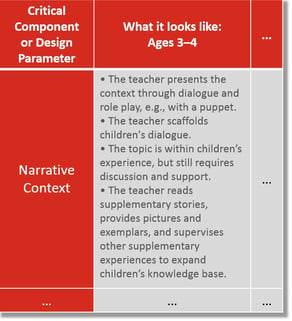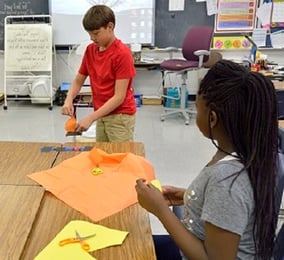 The idea of integrating engineering with traditional K-12 subjects is still pretty new. If you’re a teacher looking online for age-appropriate engineering lessons, you may find what’s on offer is too challenging—or too simplistic—for your students. And if you’re a curriculum developer, you won’t find many resources to show what kinds of engineering kids are capable of at different ages. That’s why EiE’s research team has developed a concise set of Engineering Learning Trajectories for ages 3–12.
The idea of integrating engineering with traditional K-12 subjects is still pretty new. If you’re a teacher looking online for age-appropriate engineering lessons, you may find what’s on offer is too challenging—or too simplistic—for your students. And if you’re a curriculum developer, you won’t find many resources to show what kinds of engineering kids are capable of at different ages. That’s why EiE’s research team has developed a concise set of Engineering Learning Trajectories for ages 3–12.
Understanding How Kids Learn
The new learning trajectories draw on EiE’s extensive research on “how children learn engineering.” “Kids who are twelve have different skills and abilities than kids who are three,” says EiE director Christine Cunningham. “That may seem obvious, but it’s easy to overlook.”
Consider skills related to collaboration. Four-year-olds can talk about sharing, but may not actually be willing to share; six-year-olds can usually work effectively with a partner; eight-year-olds can work in small groups; and at age 11 or so, most students can appropriately and effectively critique each other’s work within their groups.
Or consider the application of math when engineering. Four-year-olds can put things in categories (hard versus soft, loud versus quiet); six-year-olds can use tally marks; eight-year-olds can start to create graphs and line plots; 11-year-olds may be able to construct simple models. Lessons that aim too high (or too low) are frustrating for kids and their teachers.
Engineering Lessons That are “Just Right”
Our work over the past four years on the EiE initiative “Evaluating the Efficacy of Elementary Engineering” (E4) has also highlighted the need to codify engineering learning trajectories. This $3 million study, funded by the National Science Foundation, explores the hypothesis that certain critical design elements contribute to the effectiveness of elementary engineering curricula.
“To assess whether the critical design elements really are what make the EiE curriculum work so well, we had to create a comparison curriculum that lacked these critical elements,” says Cathy Lachapelle, EiE’s research team leader. “To do this, we looked for free engineering lessons online—just as most elementary teachers who are teaching engineering for the first time would do.”
Cathy and her team found that many engineering lessons listed as suitable for elementary students are actually too advanced. Cathy cites one lesson that engaged students in building a radio from a kit. “It was listed for eight-year-olds,” she says. “But there were no supports to help a young student understand what a radio is for, why you would want to make one, or how to troubleshoot if you had problems with the assembly. The reading level was too advanced for eight-year-olds. And building a kit doesn’t really help kids learn about engineering design and redesign, because instead of multiple solutions, there’s only one way to put it together.”
Steps Not Set in Stone
 Step by step, EiE’s curriculum developers and researchers looked at each critical design element to figure out how it applied to students in each age band. “The process was complicated,” notes Martha Davis, who leads EiE’s curriculum development team. “Each decision had to be supported by research; on top of that, we had to take into account that most classrooms these days are quite diverse, bringing together regular learners, English learners, and students with special needs.”
Step by step, EiE’s curriculum developers and researchers looked at each critical design element to figure out how it applied to students in each age band. “The process was complicated,” notes Martha Davis, who leads EiE’s curriculum development team. “Each decision had to be supported by research; on top of that, we had to take into account that most classrooms these days are quite diverse, bringing together regular learners, English learners, and students with special needs.”
As with all EiE projects, we’re applying the engineering design process to this one! “The steps in the EiE Engineering Learning Trajectories are not set in stone,” Davis notes. “We’re looking for feedback from teachers and from other curriculum developers.”
Do the K-8 engineering trajectories we’ve presented line up with your own classroom experience? With your own research results? Let us hear from you in the comments below.
Engineering is Elementary is a project of the National Center for Technological Literacy® at the Museum of Science, Boston.








